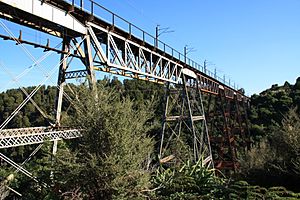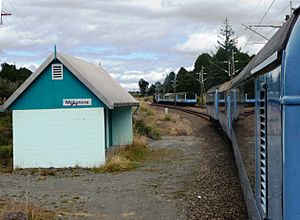Makatote Viaduct facts for kids
Quick facts for kids Makatote viaduct |
|
|---|---|

Makatote Viaduct, 2013
|
|
| Coordinates | 39°15′57″S 175°23′24″E / 39.2658°S 175.3899°E |
| Carries | Single track of the North Island Main Trunk |
| Crosses | Makatote River |
| Owner | KiwiRail |
| Characteristics | |
| Design | Plate girder and Pratt truss |
| Material | Mild steel |
| Total length | 262 metres (860 ft) |
| Height | 79 metres (259 ft) |
| Number of spans | 10 |
| History | |
| Engineering design by | PWD |
| Constructed by | J. & A. Anderson & Co |
| Construction begin | 1905 |
| Construction end | 10 July 1908 |
| Opened | 6 November 1908 |
| Designated: | 20 February 2009 |
| Reference #: | 7778 |
The Makatote Viaduct (Bridge 179) is a very important railway bridge in New Zealand. It carries the North Island Main Trunk railway (NIMT) line. This line crosses the Makatote River in the central North Island, near Ruapehu.
The viaduct is located about 335.7 km (208.6 mi) from Wellington. It sits between the Erua and Pokaka areas.
Workers built the Makatote Viaduct between 1905 and 1908. It was built for the Public Works Department (PWD). In 1909, the bridge was handed over to the New Zealand Railways Department (NZR).
When it was first built, the Makatote Viaduct was the tallest bridge in New Zealand. Today, it is the third tallest. The two taller ones are the North Rangitikei Viaduct (81 metres (266 ft)) and the Mohaka Viaduct (95 metres (312 ft)).
Contents
Building the Makatote Viaduct
Like many other bridges on the NIMT line, Peter Seton Hay designed the Makatote Viaduct. He later became the chief engineer for the Public Works Department.
Bridge Parts
The viaduct has different types of sections.
- Spans 1, 2, 3, 9, and 10 are made of strong steel plate girders.
- Spans 4 to 8 are steel Pratt trusses. Each of these is about 30.5 m (100 ft) long.
- The main supports, called piers, are also varied. Piers 1, 2, 3, 9, 10, and 11 are made of reinforced concrete.
- Piers 4 to 8 are steel trestles that sit on concrete foundations. Pier 6 is the tallest of these supports.
Construction Challenges
The company J. & A. Anderson & Co from Christchurch won the contract to build the viaduct in 1905. The project was supposed to take two years. However, the builders faced many problems.
- They had issues with the foundations.
- Bad weather and floods caused delays.
- There was a shortage of cement in 1907.
- It was hard to find enough skilled workers.
Getting Materials to the Site
Transporting materials to the remote building site was a big challenge.
- Some materials went by ship to Whanganui. From there, they were loaded onto barges and taken up the Whanganui River to Pipiriki. Then, bullock teams or traction engines carried them to Makatote.
- Later, some supplies went by train from Auckland to Oio. From Oio, a new road (now SH4) was used. As the railway line extended closer, the road journey became shorter.
On-Site Workshop
Instead of bringing large steel girders from their factory in Lyttelton, Andersons built a large workshop right at the site in 1906. This workshop was about 285 ft (87 m) long. Here, they could make the steel parts needed for the bridge.
The workshop used a wood-burning boiler and a steam engine for power. It even had electric lights and machines. Large cranes helped move heavy parts around the site. A special cableway also helped transport materials.
The last big steel girder was put into place on June 4, 1908. After that, the cableway was taken down. The railway tracks were then finished on August 3, 1908.
Safety Features
In 1949, a train part called a tender came off the tracks. Luckily, special check rails on the viaduct stopped it from falling off the bridge. This shows how important safety features are.
Keeping the Viaduct Strong
The Makatote Viaduct has been regularly checked and strengthened over the years. This is important because trains have become heavier and more powerful.
Strengthening for Heavier Trains
When the bridge was first built, it was designed for trains weighing 84 tons. But soon, heavier trains were introduced.
- From 1925 to 1932, all bridges on the NIMT line, including Makatote, were strengthened. This allowed them to carry trains weighing up to 135 or 145 tons.
- More work was done from 1983 to 1989. This added supports for electric power lines and made the bridge even stronger for modern electric trains.
Foundation Repairs
Over time, the river can wear away the ground around the bridge's foundations.
- In 1981-82, Pier 6, one of the main supports, was made stronger. New concrete cylinders were added deep into the ground.
- Later, Pier 7 also needed important repairs. In 2006, a company called Fulton Hogan began a big project to fix Pier 7's foundations. They used a lot of concrete and deep steel piles to make it stable. This work was finished in 2007.
Protecting the Bridge and Wildlife
In 2009, the Makatote Viaduct was recognized as a Category 1 historic place by New Zealand Historic Places Trust. This means it is a very important historical site.
In 2014, a large project began to repaint the viaduct. The old paint, which contained lead, was carefully removed. The bridge was covered in a special "shrink-wrap" to stop paint flakes from falling into the river. This protected the environment and the animals living nearby.
Workers used about 200 tons of a material called garnet to blast off the old paint. They then applied new paint to the entire 12,000 m2 (14,000 sq yd) surface of the viaduct.
During both the 2007 and 2014 repair projects, great care was taken to protect the local wildlife. This included rainbow and brown trout in the river, and a family of whio (blue duck) that nested near the bridge.
- In 2007, special traps were built to catch silt and stop it from getting into the river. Work was also planned to avoid disturbing the birds during their breeding season.
- From 2014, the bridge was wrapped up as the old paint was removed. The leftover paint was safely vacuumed up and stored. KiwiRail also helped by funding traps for rats and stoats along the riverbanks.
Makatote Station
During the viaduct's construction, the building camp at Makatote was a lunch stop for travelers. People would take a coach between the temporary ends of the railway line at Ohakune and Raurimu.
A temporary station, run by the Public Works Department, opened north of the viaduct on May 1, 1908. It closed on January 4, 1909, shortly after the main railway line was fully opened.
Many years later, in 1986, a new passing loop was opened at Makatote. This allows trains traveling in opposite directions to pass each other on the single track.
Images for kids




